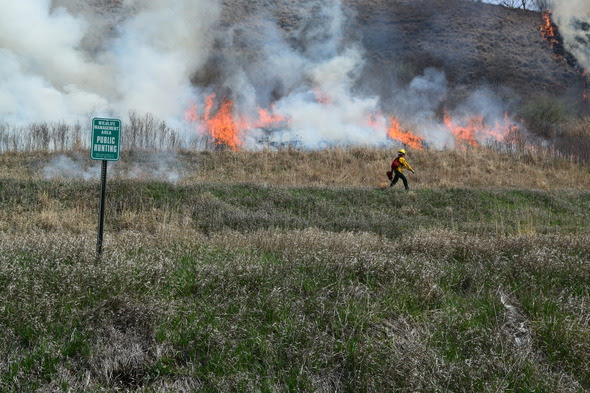
|
HAMBURG, Iowa – The torches were lit and the fire crew spread out off the east side of Bluff Road in southwest Fremont County where, on this early April afternoon, this 12-member team would be using prescribed fire on the 170-acre Eli Slusher Wanamaker Tract – a mix of prairie, grassland and timber – as part of the Loess Hills cooperative burn week.
“Keep a good pace,” shouted Kody Wohlers, Loess Hills Land Stewardship director for the Iowa Natural Heritage Foundation, who was serving as incident commander for the week.
Loess Hills cooperative burn week, now in its 10th year, provides hands-on fire management and training for all experience levels. The 2025 project took place in the southern Loess Hills, in Fremont, Mills and Pottawattamie counties. To learn more about the Loess Hills cooperative burn week, go to the DNR's YouTube channel.
“Participants have the opportunity to gain experience in different roles from incident command, to firing boss to line boss, through planning, prepping, going through safety reviews and the fire execution,” said Doug Chafa, wildlife biologist with the Iowa Department of Natural Resources (DNR) Missouri River Wildlife Unit and one of the organizers of the annual event. “Training is the primary focus but a side benefit is we get all the ecological benefits of fire on the landscape.”
Attendees came from 12 states and Canada, from 45 conservation agencies and organizations including numerous Iowa county conservation boards, The Nature Conservancy, the U.S. Fish and Wildlife Service, the Audubon Society, Henry Doorly Zoo, Pheasants Forever, city parks departments, students from Kirkwood Community College, Iowa State University and Upper Iowa University, and volunteers and numerous rural volunteer fire departments and more.
The goal of the week was to provide attendees with real world, hands-on experience in all phases of planning and executing a prescribed fire while applying fire on the landscape. For some, it was their first time on the fire line, for others, it was serving in a new role. All under the direction of a highly experienced team.
Each day began with a meeting in the Waubonsie State Park lodge, that would go through the daily schedule – hazard tree work, classroom work, live fire – depending upon the weather. As the participants broke into their smaller groups, the dozen members of Division Pink met outside the lodge for a briefing before splitting into their burn group.
After gearing up with their protective fire equipment, the burn group met by the main engine to go through burn maps and progression of the fire, potential hazards, escape plans, fire objective, medical event and radio check. They were waiting for humidity levels to drop after a steady rain passed through the area the day before.
“Rehab the torches, rehab the water, use this time for scouting, we don’t have idle time - always be doing something,” instructed Wohlers.
This fire would be directed by firing boss in training, Sarah Ratay, from The Nature Conservancy Oregon, who was working alongside John McAndrews, group leader from the Iowa DNR’s Missouri River Wildlife Unit. After arriving at the burn site, the crew did walk-throughs at each ignition point, re-reviewed the plan, pointed out the hazards and did another radio check.
Since the fire would be adjacent to Bluff Road, the Iowa DNR’s local conservation officers were engaged to provide traffic control.
Once lit, the actual fire took two hours to cover 170 acres. A morning’s worth of preparation and planning was put into action.
“We do a lot of planning on the front end to make sure the execution day and the operation goes smoothly, efficiently and very timely. It's all in the planning and the prep, and the operation day is just the fun day,” said Wohlers.
Loess Hills cooperative burn week was held March 31 – April 4, and headquartered at the lodge in Waubonsie State Park. Fire projects were conducted on an estimated 2,651 acres in Fremont, Mills and Pottawattamie counties, along with Washington County, Neb. Funding for this event is provided by The Fire Learning Network, the Loess Hills Alliance, The Gilchrist Foundation and the participating agencies.